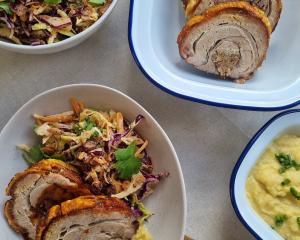Our kitchens have changed remarkably over the past century, from three-room complexes with scullery, pantry and kitchen where a housewife might spend all day cooking, through small single-room kitchens to large modern open-plan ones, which look professional but may seldom be used. Charmian Smith talks to Prof Helen Leach about her new book Kitchens.
Many things contribute to changes in kitchens - the introduction of new materials such as stainless steel, aluminium or plastics, changing fuel sources, mortgage-lending rules, women working outside the home - but, surprisingly, foods and recipes are slower to evolve, according to Emeritus Prof Helen Leach, of the University of Otago.
''One thing I found in writing this book, that even though the kitchen material culture, the artefacts and so on, undergo phenomenal transformations, the food doesn't.
"It's always more conservative. We often evaluate new appliances by how well they can make our traditional dishes and whether they can save us time making our traditional dishes,'' she said.
Her latest book, Kitchens: The New Zealand Kitchen in the 20th Century (Otago University Press) follows earlier books on the history of the Christmas cake and the pavlova.
Although there have been big changes in kitchens over 100 years, it has been gradual and reflects what was happening in society: women working outside the home, new fuels such as electricity, new foods such as factory-farmed chicken, new appliances such as food processors or electric frying pans and even government regulations on mortgage lending, she said.
She has also included suggested daily menus for breakfast, lunch and dinner for each decade, choosing menus suggested for ordinary households or people on budgets rather than for wealthy households or entertaining.
• Breakfast in the first part of the century was always cooked and only became simple in the past few decades, the boiled egg being the last remnant of the home-cooked breakfast.
An Edwardian dinner menu was five courses: soup or fish, entree, roast or meat course with vegetables, then pudding which was followed by cheese savoury, which could be as simple as cheese and biscuits or as stodgy as macaroni cheese.
One menu from Mrs Miller's Improved economic cookery book (1901) recommended fish cakes or oyster patties; rolled rib of beef roasted, horseradish sauce, potatoes, cabbage; chocolate pudding, apple or rhubarb compote, followed by Welsh rarebit.
Potatoes were sometimes served three times a day and sometimes in two ways at the same meal such as roasted round the joint and boiled.
It's no wonder it took a housewife most of the day to feed her household.
The main meal quickly reduced to three then two courses, but puddings hung on until the 1990s, when they could be replaced by a piece of baking.
''International'' dishes such as spaghetti Bolognese, quiche lorraine or Chinese stir-fries came into fashion in the 1960s, and people started growing their own herbs and experimenting with spices, she said.
It wasn't until the 1970s that other starches like rice or pasta sometimes took the place of potatoes.
As more women worked outside the home, new foods were introduced that were quicker to cook, such as frozen vegetables.
Chicken had been a special occasion roast and sheepmeat had been wether mutton or hogget as most of the lamb was exported, but in the 1970s factory-farmed chickens became available and pieces such as legs or breasts could be cooked quickly in the new electric frying pan when a parent came home from work.
Lamb and the new cuts of trim pork also cooked conveniently quickly.
Or you could put your meat dish on in the crockpot before you went to work and cook the vegetables quickly in the microwave when you came home, she said.
By the end of the century several people might be working in the kitchen at once, men, women and children, but for short periods of time.
• Kitchens in Edwardian villas had three rooms, a scullery with a sink for dirty work, a walk-in pantry for storing food, and a kitchen with the stove for cooking and a table for working on and eating at.
Households were large and although wealthier ones had servants, daughters or other women in the household would work in the kitchen.
As bungalows became the norm, kitchens became compact, single rooms with usually just the housewife working there. The show kitchen in the 1925 New Zealand and South Seas exhibition in Dunedin was pivotal in changing ideas about kitchens, she said.
''Three million people went to that and all of the women would have looked at that kitchen and gone: `Mmm'. It would have given them something to dream about.''
The middle of the century brought very small kitchens and Prof Leach was intrigued to learn they were a result of government lending policies.
''I didn't know that State Advances wouldn't lend on old houses for quite a long time so to get a cheap loan after World War 2 young families basically had to sign up to go out to a new suburb and live in a new house, but the new house was constrained in terms of its size by government rules. There were set sizes and there was a set proportion of that size devoted to a kitchen,'' she said.
This was in the late 1940s and '50s, when baby-boomers were children, and large families were jam-packed into small kitchens, she said.
People with better means bought old villas and altered the kitchens: modular kitchens became available and in the 1960s open-plan kitchens with central peninsulas that divided the dining room/playroom from the work area meant the housewife could keep an eye on young children without them being under her feet.
In the 1990s, as household numbers declined, kitchens became showplaces, large and sleek with stainless steel to look more ''professional'' with central islands at which guests could sit to watch the cook(s) perform, she said.
• At the beginning of the 20th century, cooking was done on a solid-fuel stove burning coal or coke or wood, which also heated the water.
Gas stoves might be used if there was a town gas supply, but often in addition to the coal range.
Coal ranges wouldn't fit into the new, small bungalow kitchens from the 1920s, but electric stoves were becoming available.
''Electricity was quite expensive but you could hire a gas stove. Then gas introduces a thermostat in the oven, the Regulo that makes a huge difference to cooks.
"There are wonderful advertisements showing women being released by Regulos in the 1920s! This gave a real boost to gas and gas remained very popular where it was supplied, until the 1950s.''
Gas was also more reliable, as power cuts were common before the Roxburgh dam was commissioned in 1957.
As a child in the 1950s Prof Leach remembers doing homework by Tilley lamp during power cuts, while her father got the coal range going, she says.
Electricity won out eventually as it could power small appliances as well as big ones, and in the 1980s councils shut down their gasworks, which were not only dirty and polluting with toxic by-products, but also, at more than a century old, reaching the end of their lives.
Only in the 1990s when natural gas was introduced did gas cooktops re-emerge in New Zealand kitchens.
Electricity was clean, stoves were improving, thermostats were fitted after World War 1, then glass windows were built into the doors, and cooktops were separated from wall ovens which meant you didn't have to bend to get your large joint out of the oven, she said.
''It amuses me that many of those wall ovens have gone back under benches and people are bending again.''
But despite wall ovens and separate hobs, most people probably bought free-standing ranges which were cheaper.
What many people don't realise is that from the 1930s to the 1980s import restrictions meant that virtually all appliances, from stoves and fridges to food processors were made here, employing many people, she said.
Only wealthy people could afford fridges before World War 2. By the late 1950s most people had one.
In the 1960s and '70s freezers became popular.
Prof Leach was surprised by how early small appliances appeared and the range available.
Wellington department store Kirkaldie and Stains had window displays of ovenettes, grillers, toasters, electric jugs and coffee percolators during World War 1 and after the war New Zealanders pounced on them because they were relatively cheap, she said.
''You could cook breakfast on a rangette before you got the coal range going, and you could use it in summer when it would be too hot for the coal range.''
Our kitchens these days are filled with a host of small appliances.
Some, like those mentioned above have been around nearly a century, electric food mixers and blenders came in during the '50s, as did pressure cookers, electric frying pans in the 1960s, pop-up toasters, kettles that switched themselves off when they boiled, dishwashers and range hoods in the '70s, microwaves, crockpots and food processors in the 1980s, and breadmakers in the 1990s.
The microwave and breadmaker introduced electronics into the kitchen but there was never a big deal made of it, she said.
''A lot of people had found programmable appliances quite hard to handle, so in a way electronics slipped into the kitchen and we were told they were 'smart' or 'soft touch' but we weren't told about the wonderful microprocessor that was sitting behind the front keypad making all these complex decisions.
''They were unbelievably complex for the microwave. It was listening to its sensors and deciding how much steam was coming out and then it would judge how much longer the thing should have. They were very smart things but their potential was probably never fully utilised.''
• Stainless steel made its appearance after World War 1, first for cutlery and then sinks and benchtops.
Before that steel knives had to be dried and polished in a knife cleaner to prevent them rusting, she said.
''Stainless steel was very dramatic - think of all the metal things in the kitchen that are now stainless steel - benches, cutlery, pots, trays - then in the 1990s we went crazy about wanting to have the fronts of our appliances and cupboards stainless steel.
"It plays on women's and men's desire to be seen as almost professional - it gives you a professional look - to quote an advertisement.''
Plastic in many forms, from laminated surfaces for benchtops and cupboard doors and vinyl for floor coverings to linings of fridges and plastic bags and cling film, made a big difference in kitchens, not only in decor colours and ease of cleaning, but also in food hygiene, she said.
''Often the simplest and cheapest things have been the the most revolutionary, like the rise of the plastic bag and plastic wrap.
"I think plastic wrap is responsible for a major improvement in health and food safety because you can cover the dish with the leftovers in it while it is still hot, before anything has a chance to start growing on it, then you pop it in your fridge and it's sealed.''
The book
Kitchens: The New Zealand Kitchen in the the 20th Century, by Helen Leach, is published by Otago University Press.
The launch
The public is invited to attend the launch of Kitchens on Wednesday, November 12, from 6pm-7.30pm at the Dunedin Gasworks Museum, 20 Braemar St, South Dunedin.












